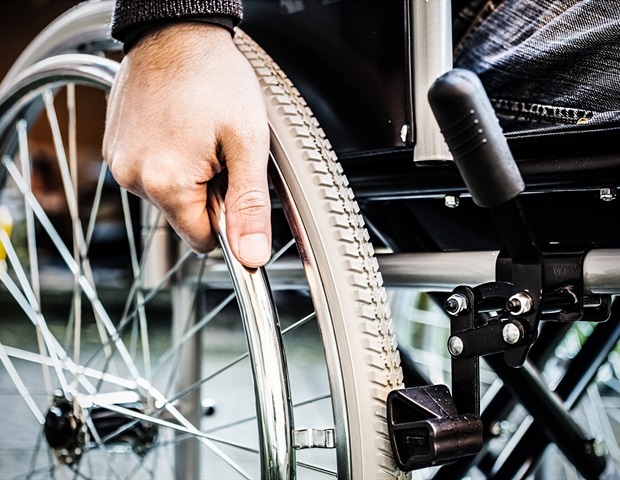Refurbished walkers and wheelchairs fill gaps created by supply chain problems
Michele Lujan needed a wheelchair for her 52-year-old husband who had been hospitalized with covid-19. But she had lost her job, and money was tight. Insurance wouldn't cover the cost, and she didn't see the use in buying something to meet a temporary need. So she turned to a loan closet not far from her home in the Denver suburb of Highlands Ranch.
At South Metro Medical Equipment Loan Closet, crutches hung from the walls, knee scooters lined the floor, and shower seats and toilet risers overflowed from the shelves. She found a wheelchair she could borrow for free.
"I didn't realize all the other medical items they have," Lujan said.
Medical equipment reuse programs like these collect, clean, and lend devices — often at no cost to the borrower. They vary in size from small outposts at community churches to large statewide programs like the Foundation for Rehabilitation Equipment and Endowment, or FREE, which provided nearly 5,000 devices to thousands of low-income adults and seniors in Virginia last year.
Such programs save low-income and uninsured patients money, and by refurbishing used medical equipment, they keep it out of landfills. During the pandemic, the programs have also helped soften the impact of supply chain-related shortages and are helping meet increased demand as delayed elective surgeries resume.
"Once hospitals started elective surgeries again, there was a huge increase in need," said Donna Ralston, who founded the South Metro Medical Equipment Loan Closet six years ago in a 10-feet-by-10-feet shed at her church.
Today, the volunteer-run organization opens its warehouse doors by appointment to anyone who is in need and recovering from surgery, illness, or injury. "Oftentimes, we're loaning equipment to patients who would otherwise have to wait two months to get it from their insurance providers," said the organization's president, Pat Benhmida. "We fill in these cracks quite often."
Besides insurance delays, hospitals across the U.S. have reported not having enough walkers, crutches, canes, and wheelchairs. Supplies are limited because of shortages of raw materials such as aluminum, said Alok Baveja, a professor of supply chain management at Rutgers Business School in New Jersey.
"The availability, not just the cost, has an impact on the durable medical equipment industry," Baveja said.
The crunch may be made worse by disruptions caused by Russia's invasion of Ukraine, said American Hospital Association spokesperson Colin Milligan.
Aluminum prices have more than doubled in the past two years, including more than 20% over the past six months on the London Metal Exchange. A bill that passed Congress April 7 to suspend normal trade relations with Russia will allow President Joe Biden to raise tariffs on aluminum and other imports from that country, increasing aluminum prices even more.
Baveja said one silver lining of the pandemic is that reused medical equipment has gained greater acceptance and use.
Last September and again in January, southwestern Virginia hospitals delayed discharging patients because of shortages of walkers and bedside commodes, and they experienced backlogs of patients in the emergency room because of a shortage of hospital beds, said Robin Ramsey, executive director of FREE, a nonprofit organization.
Ramsey said that for weeks, FREE was the only provider that had walkers and bedside commodes readily on hand. "During the shortage, we found that even people with insurance, who could have purchased a walker, just couldn't find one," Ramsey said.
Each state receives money to provide technology to help people with disabilities as part of the federal Assistive Technology Act of 1998. That can include reusable technology and equipment. Reuse programs rely on cash and equipment donations, and often an army of volunteers who inspect, sanitize, and repair wheels, brakes, casters, batteries, and other parts.
AT FREE, more than 100 volunteers and 12 staffers last year received 10,000 pieces of donated equipment, and refurbished 6,500 to put back into use, Ramsey said.
Elliot Sloyer, founder of a Stamford, Connecticut, nonprofit called Wheel It Forward, said patients and their families often pay out-of-pocket for durable medical equipment, especially with high-deductible health insurance plans. "Medicare, insurance don't cover a lot of stuff. They make it difficult," he said.
Medical equipment reuse programs provide significant, practical value to communities, said Ramsey. But, she said, some people have no idea these programs exist until they need them.
Regional directories such as the Great Lakes Loan Closets list reuse programs in Michigan, Wisconsin, northern Indiana, and northern Illinois. Wheel It Forward plans to launch the first nationwide directory of about 700 medical equipment reuse programs.
For now, reuse programs like FREE will continue to stockpile and repair donated medical equipment.
"There are times, especially with all that's gone on in the last two years, that equipment comes in and goes out the same day," Ramsey said. "The need has been so great."
|
|
Posted in: Healthcare News
Tags: covid-19, Crutches, Health Insurance, Hospital, Knee, Medicare, Pandemic, Public Health, Seniors, Surgery, Wheelchair, Wheelchairs
Source: Read Full Article

 This article was reprinted from khn.org with permission from the Henry J. Kaiser Family Foundation. Kaiser Health News, an editorially independent news service, is a program of the Kaiser Family Foundation, a nonpartisan health care policy research organization unaffiliated with Kaiser Permanente.
This article was reprinted from khn.org with permission from the Henry J. Kaiser Family Foundation. Kaiser Health News, an editorially independent news service, is a program of the Kaiser Family Foundation, a nonpartisan health care policy research organization unaffiliated with Kaiser Permanente.